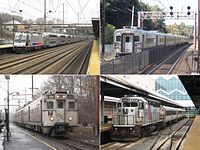
New Jersey Transit Corporation, branded as NJ Transit or NJTransit and often shortened to NJT, is a state-owned public transportation system that serves the U.S. state of New Jersey and portions of the state of New York and Pennsylvania. It operates bus, light rail, and commuter rail services throughout the state, connecting to major commercial and employment centers both within the state and in its two adjacent major cities, New York City and Philadelphia. In 2022, the system had a ridership of 175,960,600.
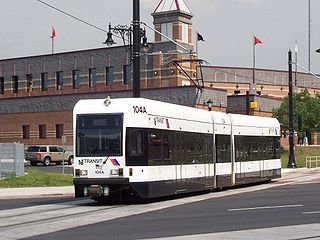
The Newark Light Rail (NLR) is a light rail system serving Newark, New Jersey and surrounding areas, owned by New Jersey Transit and operated by its bus operations division. The service consists of two segments, the original Newark City Subway (NCS), and the extension to Broad Street station. The City Subway opened on May 16, 1935, while the combined Newark Light Rail service was officially inaugurated on July 17, 2006.

General Electric Genesis is a series of passenger diesel locomotives produced by GE Transportation, then a subsidiary of General Electric. Between 1992 and 2001, a total of 321 units were built for Amtrak, Metro-North, and Via Rail.

The Northeast Corridor Line is a commuter rail service operated by NJ Transit between the Trenton Transit Center and New York Penn Station on Amtrak's Northeast Corridor in the United States. The service is the successor to Pennsylvania Railroad commuter trains between Trenton and New York, and is NJ Transit's busiest commuter rail service. After arrival at New York Penn Station, some trains load passengers and return to New Jersey, while others continue east to Sunnyside Yard for storage. Most servicing is done at the Morrisville Yard, at the west end of the line.

Newark Penn Station is an intermodal passenger station in Newark, New Jersey. One of the New York metropolitan area's major transportation hubs, Newark Penn Station is served by multiple rail and bus carriers, making it the seventh busiest rail station in the United States, and the fourth busiest in the New York City metropolitan area.

NJ Transit Rail Operations is the rail division of NJ Transit. It operates commuter rail service in New Jersey, with most service centered on transportation to and from New York City, Hoboken, and Newark. NJ Transit also operates rail service in Orange and Rockland counties in New York under contract to Metro-North Railroad. The commuter rail lines saw 45,838,200 riders in 2022, making it the third-busiest commuter railroad in North America and the longest commuter rail system in North America by route length.
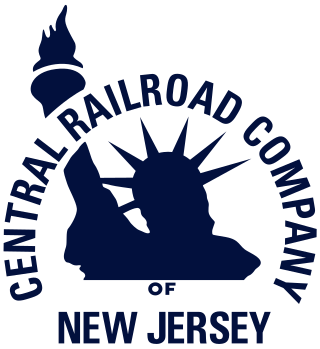
The Central Railroad of New Jersey, also known as the Jersey Central, Jersey Central Lines or New Jersey Central, was a Class I railroad with origins in the 1830s. It was absorbed into Conrail in April 1976 along with several other prominent bankrupt railroads of the Northeastern United States.
The Waterfront Connection allows NJ Transit trains to switch from the former Pennsylvania Railroad main line to the former Delaware, Lackawanna and Western Railroad main line, now NJ Transit Rail Operations. The connection opened on September 9, 1991, at a cost of $16 million.
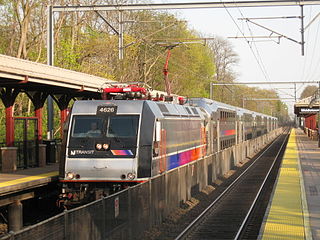
The North Jersey Coast Line is a commuter rail line running from Rahway to Bay Head, New Jersey, traversing through the Jersey Shore region. Operated by New Jersey Transit, the line is electrified as far south as Long Branch. On rail system maps it is colored light blue, and its symbol is a sailboat. The line runs along the former New York & Long Branch Railroad, which was co-owned by the Central Railroad of New Jersey and the Pennsylvania Railroad.

The Raritan Valley Line is a commuter rail service operated by New Jersey Transit (NJT) which serves passengers in municipalities in Union, Somerset, Middlesex and Hunterdon counties in the Raritan Valley region in central New Jersey, United States. The line's most frequent western terminus is Raritan station in Raritan. Some weekday trains continue farther west and terminate at the High Bridge station, located in High Bridge. Most eastbound trains terminate in Newark; passengers bound for New York make a cross-platform transfer. A limited number of weekday trains continue directly to New York.

The Aldene Connection is a connection between two railroad lines in the Aldene neighborhood of Roselle Park, New Jersey, United States, one formerly belonging to the Central Railroad of New Jersey (CNJ), the other formerly of the Lehigh Valley Railroad. The connections allow trains on the New Jersey Transit Raritan Valley Line to travel from Cranford and points west through stations in Roselle Park and Union to the Hunter Connection in Newark, which in turn allows access to the Northeast Corridor and Newark Penn Station.

The Atlantic City Line (ACL) is a commuter rail line operated by NJ Transit (NJT) in the United States between Philadelphia, Pennsylvania and Atlantic City, New Jersey, operating along the corridor of the White Horse Pike. It runs over trackage that was controlled by both the Pennsylvania Railroad (PRR) and the Pennsylvania-Reading Seashore Lines. It shares trackage with SEPTA and Amtrak on the Northeast Corridor (NEC) until it crosses the Delaware River on Conrails Delair Bridge into New Jersey.
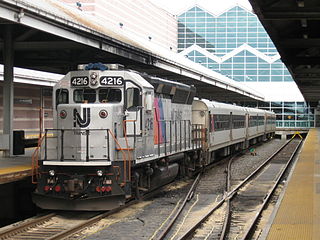
The Atlantic City Rail Terminal is Atlantic City, New Jersey's train station, located inside of the Atlantic City Convention Center. It has five tracks served by three platforms and functions as the easternmost terminus of the NJ Transit Atlantic City Line to and from Philadelphia. The station was also served by the Atlantic City Express Service (ACES) from 2009 until it was formally discontinued on March 9, 2012.

The passenger locomotives derivatives of the General Motors EMD GP40 diesel-electric locomotive have been, and continue to be, used by multiple passenger railroads in North America. For passenger service, the locomotives required extra components for providing steam or head-end power (HEP) for heating, lighting and electricity in passenger cars. Most of these passenger locomotives were rebuilt from older freight locomotives, while some were built as brand new models.

The Atlantic City Express was an Amtrak train that ran from both Harrisburg, New York City, Richmond, Springfield and Washington, D.C. to Atlantic City, New Jersey, in the Northeastern United States. The train operated on the Northeast Corridor to 30th Street Station in Philadelphia, Pennsylvania, where it went east to Atlantic City.
The West Trenton Line is a proposed NJ Transit (NJT) commuter rail service that would be operated mostly on the CSX Transportation Trenton Subdivision, connecting West Trenton Station in Ewing Township, New Jersey with Newark Penn Station in Newark, New Jersey. The route would connect with the Raritan Valley Line at Bridgewater and the SEPTA West Trenton Line at West Trenton. As of 2007, NJT's estimate of the cost of creating a passenger line to West Trenton was $219 million. The project is still on the books, but no funding for the proposal has been secured to this date.

Harrah's Resort Atlantic City is a casino hotel in the marina district of Atlantic City, New Jersey, owned by Vici Properties and operated by Caesars Entertainment. Harrah's is one of the largest hotels in New Jersey.
Light rail in New Jersey is provided by NJ Transit, a state-owned corporation which also provides bus and commuter rail services. In 2022, the light rail system had a ridership of 17,495,800. Light rail, among other forms of transit, is a major part of the state's Smart Growth policy.

The Crusader was a 5 car stainless steel streamlined express train that ran on a 90.3-mile (145.3 km) route from Philadelphia's Reading Terminal to Jersey City's Communipaw Terminal, with a ferry connection to Lower Manhattan at Liberty Street. The Reading Railroad provided this service in partnership with the Central Railroad of New Jersey (CNJ), in which it was the majority owner of capital stock. Trains including the Crusader ran on Reading Railroad tracks from Reading Terminal in Philadelphia to Bound Brook, NJ, where they continued on CNJ tracks to Communipaw Terminal in Jersey City. Passengers then left the train and walked aboard the ferry or boarded busses that loaded onto the ferry. Introduced in 1937, the Crusader service declined during the 1960s, and the name was ultimately dropped in 1981.

The Adessia Max, originally branded and still commonly known as the MultiLevel Coach, is a bi-level passenger rail car for use on commuter rail lines. The first units were delivered by Bombardier Transportation in 2006 for New Jersey Transit and Montreal's Exo. Over 643 have been delivered in various orders, including a later purchase by Maryland's MARC. NJ Transit ordered an additional 113 cars in 2021 from Alstom, which purchased Bombardier.



















